This is the post I made when I became 100% convinced of the change:
http://marcoparigi.blogspot.com.au/2016/05/anuket-neck-crack-after-and-before.html
Of course, I realise I hadn't explained it well, and in some ways it seemed obvious, but the following blog post is rich in detail, explanatory notes and close images from varying angles. I challenge anyone to make a counter claim on what is happening on Anuket.
Reblogged from
https://scute1133site.wordpress.com/
BEFORE:

AFTER- the red dot has moved. Old position marked with a smaller dot. Please ignore the red smudges below the green line.


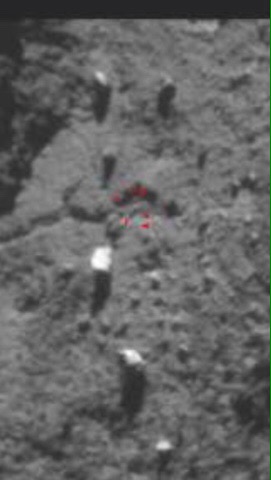
Copyright ESA/Rosetta/NAVCAM – CC BY-SA IGO 3.0
(All photos are from the NAVCAM except one OSIRIS photo which is credited inline. Full credits at bottom).
INTRODUCTION
In June 2016, Marco Parigi published a blog post in which he suggested that a boulder on Anuket appeared to have moved. Here’s the post.
http://marcoparigi.blogspot.co.uk/2016/06/anuket-near-crack-changes.html?m=1
Whilst the apparent movement looked real and compelling, the various photos of the Anuket neck that I’d seen so far didn’t show enough detail for a detailed analysis. They needed to show the boulder actually sitting on one side of a small, local feature in one photo and then sitting on the opposite side of that feature in a later photo. The feature, whatever it might be (a small crack or ridge or discolouration) would then be acting as a reference point or fiduciary point to betray the boulder’s movement.
Recently, I was browsing another of Marco’s posts on a related change close to the boulder in question. I realised that the photos in that post had sufficient detail to look for fiduciary points that the boulder had slid past. Here’s that post, from which the photos further below were culled.
http://marcoparigi.blogspot.co.uk/2016/07/tekhenu-region-overhang-collapse-into.html?m=1
The two photos from the link above are the two main photos used in this post. Others are added further down for extra evidence.
THE PHOTOS
Photos 1 and 2- the triangle of boulders. Originals are included where appropriate but not included in the numbering system.

 .
.

Red- Marco’s boulder that was suggested as having moved. Smudged red is an old artefact. Please ignore.
Light blue- the other two boulders that could be considered to be the base of the triangle. That base stayed the same width but as the triangle appeared to elongate due to the red boulder movement, the base went from looking fairly wide to being comparatively narrow when compared with the height of the triangle.
Photos 3 and 4- photo 3 shows the position of the red boulder before the movement. Photo 4 shows it after the movement. These are the header photos, reproduced.

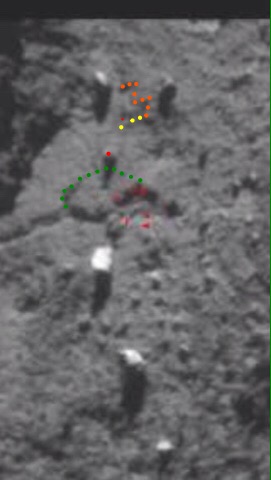


Red- the boulder. Also, in the after photo, the tiny red dot above the actual boulder shows its original location as in the before photo.
Yellow- a slightly curved feature which leads up to the base of the red boulder before it moves and is marooned above the boulder after it’s moved. This is proof that the red boulder did indeed move.
Orange- a distinctive ‘W’ shape that’s visible in both photos. It’s useful as a a general fiduciary point. It can then be seen that the yellow feature branches off one end of the W in both the before and after photos. You need to look at the unannotated versions to see the W once the dots have shown you where to look for it.
Green- this traces the line of a distinctive quasi-triangular feature, part of which collapsed into the main Anuket crack between the before and after pictures. That collapse was documented by Marco in the second blog post linked above. You can see that in the before picture, the red boulder is some distance from the apex of the green triangle. In the after picture, the red boulder is almost kissing the apex. This, along with the marooned yellow feature proves that the red boulder did move.
Photo 5- this is the same as photo 3 but with a single added tiny red dot. This shows the location to which the red boulder would subsequently move.
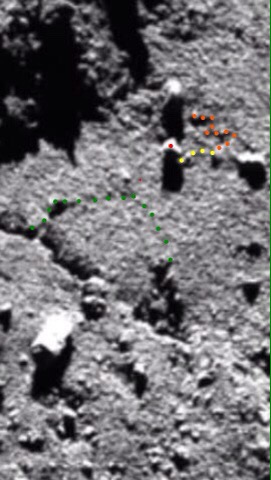
USING SHADOW LENGTHS TO PROVE THE MOVEMENT
The lighting in the before photo is similar to that in the after photo. This always makes comparison between features somewhat easier. However, in this case it allows us to check the length of the shadow cast by the red boulder in each case. If we then identify the position of the tip of the shadow for the after shot we can go to the before shot and annotate a shadow from the red boulder in that shot all the way to the known shadow tip in the after shot.
The reasoning here is that if the comet is static and nothing moved, the boulder/shadow geometry for the after shot would be the same as for the lighting-manipulated before shot. It stands to reason that if the after shot lighting angle is faithfully reconstructed in the before shot, the shadow tip of the red boulder absolutely has to reach the same spot in both cases. So our annotated before shot simply assumes the same lighting angle that pertained in the after shot and casts the drawn shadow to the apex that it would definitely reach under the same lighting conditions as the after shot. The result is a ridiculously long shadow, well over twice as long as it should be. So that proves the red boulder moved too. The shadow reconstruction photos follow.
Photos 6 and 7- the red boulder and its shadow (6 is the before shot).
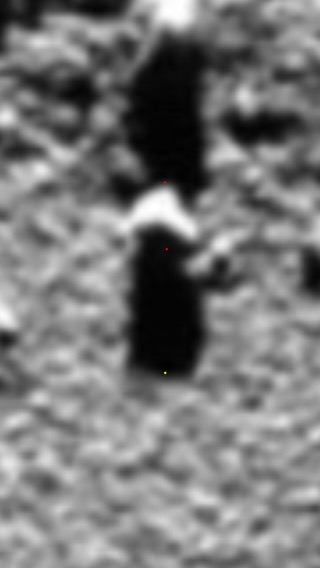

Red- the two sides of the boulder in both cases. The side in shadow is estimated. It may be argued that it would be better to measure the visible width and compare it to the shadow length instead but it just so happens that the distance between the red dots is the same as the width at its widest point and this is the case in both photos. So both methods apply with the boulder/shadow ratios we’re about to calculate.
Yellow- the shadow tip.
The ratio of shadow to boulder is 1.82 for the before shot and 1.58 for the after shot. There’s obviously an error margin involved but they are both certainly well under a ratio of 2.
Photo 8- identifying the tip of the shadow in the after shot (yellow dot).

Photo 9- transposing the shadow tip location for the after shot to the before shot (yellow dot).

Photo 10- this is the annotated shadow set-up. The set-up assumes the red boulder never moved and that it’s lit from exactly the same angle as for the after shot. These two assumptions have to result in the shadow reaching the location of the yellow dot. The shadow is annotated accordingly. The ratio of shadow to boulder is 4.16. That’s well over double what it should be, in fact 2.63 times more than the after shot ratio of 1.58. You can see that even the (real) 1.82 ratio shadow in the photo is dwarfed by the ludicrously long annotation.
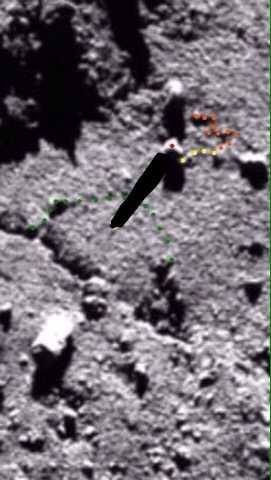
This anomaly is very difficult to explain for a boulder that never moved. The obvious solution for obtaining anything near the required 1.58 ratio is to give the boulder a very noticeable shunt to the left.
THE BLUE ROCK MOVED TOO
This happens quite often when looking in detail at one particular phenomenon. You suddenly realise something else nearby has also torn, slid, delaminated or collapsed. The right hand light blue boulder also slid (or rolled).
Interestingly, it slid up the neck in the opposite direction to the red boulder.
Photos 11 and 12- the blue boulder slide.

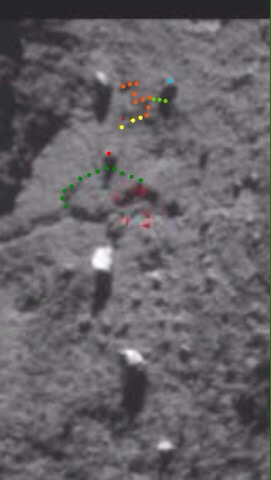


Light blue- the sliding boulder.
Bright green- three dots next to the light blue boulder. These denote an actual line that runs at 90° to the base of the ‘W’. You can see that the blue boulder is below the line in the before shot and above it in the after shot. Please look at the originals to confirm this. The bright green line is obvious and the boulder movement unequivocal but the dots obscure the line itself.
THE AREA HOSTING THE TWO SLIDING BOULDERS IS FLAT


Photos 13 and 14
There has been a suggestion in the comments on the Rosetta blog that the red boulder might be sitting at the top of a slope so that parallax alone accounts for what is actually just apparent movement. At a low-profile angle and looking from below (as in some of these photos) it would then appear to be closer to its light blue twins than it really is. As you rise up the neck to look vertically down at 90° to the surface, the parallax element would not take effect and the full distance between red and blue would be betrayed. The difference in the two cases would amount to apparent movement of the red boulder.
The detailed analysis above proves that the two boulders moved anyway, whether such a slope exists or not but it’s as well to address the issue here so that it’s laid to rest.
The simple solution to establish whether there is indeed such a slope is to look at the area from the side and from low down. If it’s there it will be shown up in full. The two photos below show that no such slope exists. Photo 13 is a before shot and photo 14 is an after shot. The before shot has the boulder triangle annotated because it’s so faint and the nearer blue boulder is as good as whited out. Seeing as these are both essentially side views, flat and with no parallax slopes it’s quite clear that the red boulder has moved. The movement is evidenced in the the spaced-out triangle.
“THE TRIANGLE SEEMS MORE SPACED OUT”
That sub-heading is a quote from Marco’s original post on the boulder, the one that’s linked above. Time and again in the course of working out what the 67P morphology is telling us, we notice something that looks odd but can’t state quite why it looks odd. We might pass over it dozens of times on the way somewhere else, scratching our heads every time, remembering that the paradox is as yet unresolved.
In this case it was the fact that “the triangle seems more spaced out” and yet the degree of movement of the red boulder didn’t seem to warrant it being quite that spaced out. Then, whilst annotating the photos for this post, the paradox was automatically resolved. The triangle is now more spaced out because the top-right boulder moved upwards. That’s why the triangle is now so long and thin.
The two light blue boulders remained essentially the same distance apart while the right hand one moved up. Since they constitute the short base of the triangle, the base remained the same width but shunted back a bit on one side. Combining that with the red boulder extending the long tip explains the spaced out triangle.
And, more importantly, we now have two boulders that have moved and they’ve moved in opposite directions: straight up and straight down the neck.
TWO MORE BEFORE/AFTER PHOTOS TO COMPARE
Since you should now be more familiar with the fiduciary points, these two photos are, for the most part, left unannotated. However the two closest zoom components each have an annotated version. The annotations are the same colours as for the header (reproduced with their key in photos 3 and 4). There are eight photos, four versions of each as follows: original, medium zoom, close zoom, close zoom annotated. They’re presented in pairs for comparison of course.
Photos 15-22
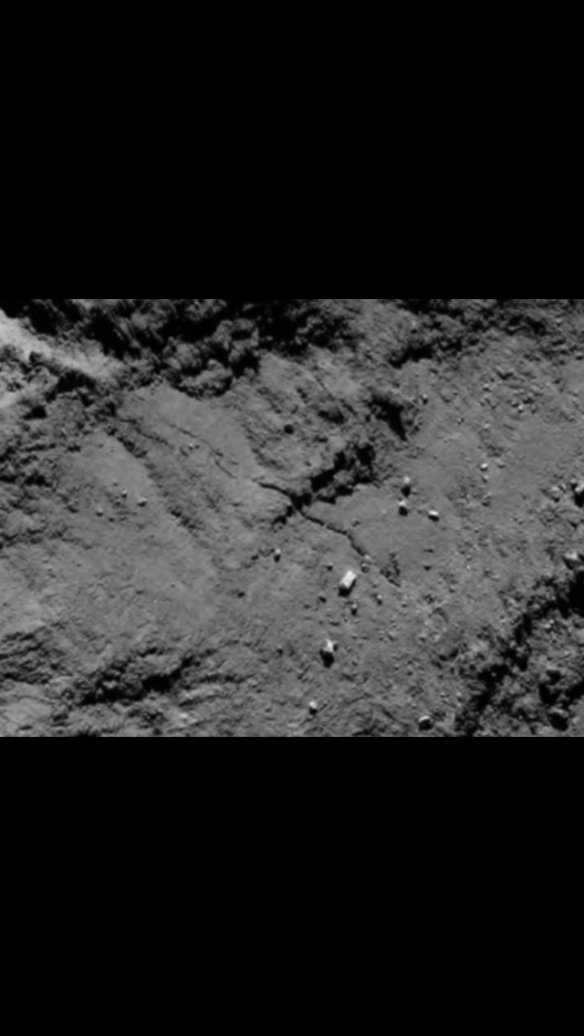
Credit ESA/Rosetta/MPS for OSIRIS Team MPS/UPD/LAM/IAA/SSO/INTA/UPM/DyASP/IDA/






Credits: ESA/Rosetta/MPS for OSIRIS Team MPS/UPD/LAM/IAA/SSO/INTA/UPM/DyASP/IDA/A.COOPER
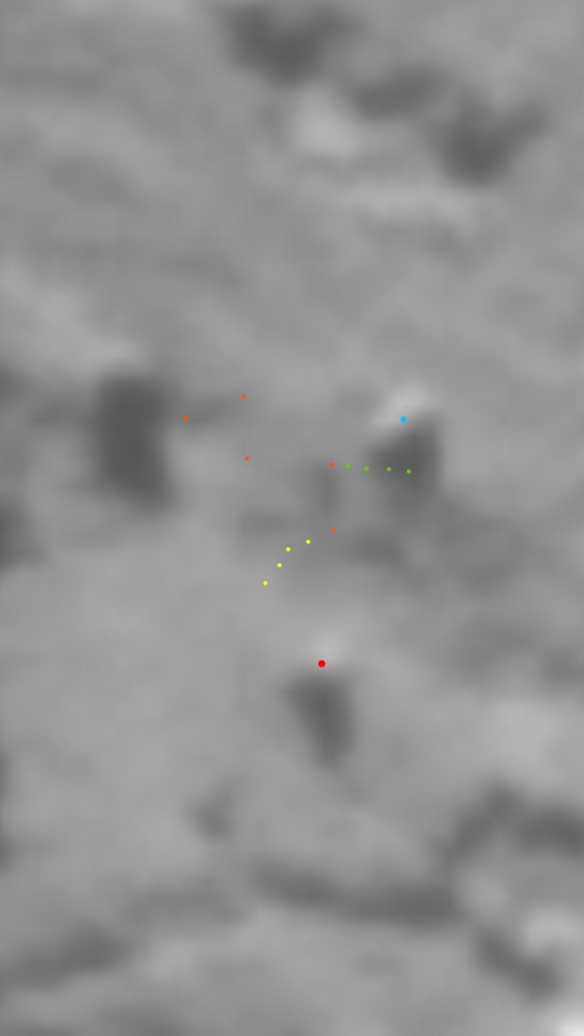
REASON FOR THE BOULDER MOVEMENT
The reason for the movement of the two boulders and the fact they have moved in opposite directions will probably get its own post when other evidence avails itself, as it usually does. However, as a prelude to such an analysis, one possible reason for the red boulder moving down the neck is the subsidence of material into the neck crack only a short distance away. That’s described in the second link above and it’s placed here as well for convenience:
http://marcoparigi.blogspot.co.uk/2016/07/tekhenu-region-overhang-collapse-into.html?m=1
It would be odd if the two events, collapse and boulder movement, were unrelated when in such close proximity and while such little change has been noticed elsewhere on the comet (notwithstanding Marco’s other Anuket neck change discoveries and the Imhotep slump). It could be argued that the collapse into the crack, being only 100 metres or so away, caused a slight trough between that apex of the subsided material and the boulder, enough for it to affect the gravity gradient and allow the boulder to slide or roll in that direction.
Slumping in any situation is prone to cause sympathetic ground movement around the slump. Indeed there is some indication in the photos of a slight trough in the after photos but it’s to the right of the slide track and could be the lighting anyway. We await the OSIRIS after photos.
As for the blue rock moving up the neck, there are delaminations in that direction as a result of stretch. The boulder triangle is sitting right next to the ‘orange tell-tale line’, after all. That line is itself a one-kilometre-long delamination from head rim to body (Part 25 of this blog).
STRETCH THEORY AS A PREDICTIVE TOOL
Another reason for citing delaminations is this. That orange ‘W’ in the pictures above was just a random feature in my mind until I realised that there was a boulder placed neatly at each end and one in the middle. One boulder for each apex. We already know from experience that delaminations often leave boulders behind as they shunt away from a particular position. They tend to shed talus from obviously ragged cliffs (see Part 50) and chunky boulders from squared-off cliffs (e.g. the Hapi boulders and the three Aker boulders).
The W is very blocky or you might say, squared off, and there are chunky boulders right next to it as if related to it. The knowledge of blocky cliffs shedding large boulders, derived only from stretch theory, prompted me to hunt for another W without even knowing whether one existed at all.
Stretch theory also told me where to look: one or two hundred metres up the neck, possibly with a circa 45° southerly bias. The upward component is due to the obvious neck stretch vector (Part 25). The southerly bias is because everything was delaminating along the shear line and around the soon-to-be head rim just before head shear. Those delaminations have been identified (not blogged yet but tweeted). The combination of southerly delamination before head shear and easterly (up the neck) delamination during neck stretch results in a circa 45° vector-summed resultant direction. So that’s where I looked first. And sure enough, there it was:

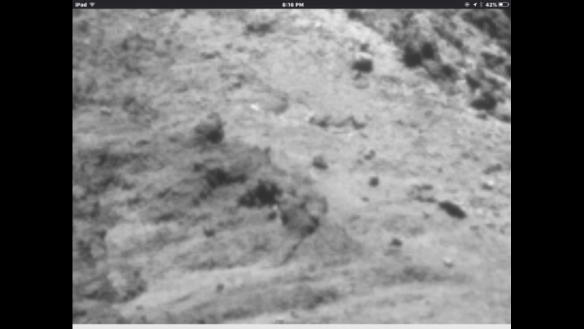
Photo 23
That’s the predictive power of stretch theory and it’s why the boulders got left behind in that ‘W matches the boulder triad’ configuration.
Photo 24- the same as photo 23 but with the boulder dots depicting the triangle in the ‘before’ configuration.
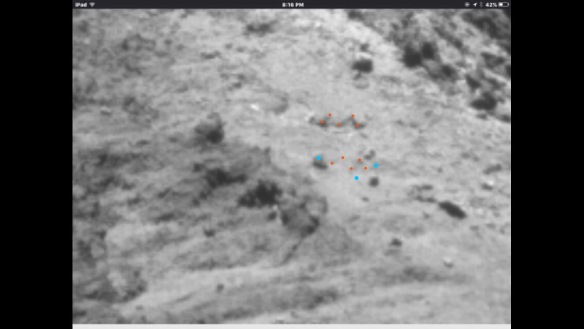
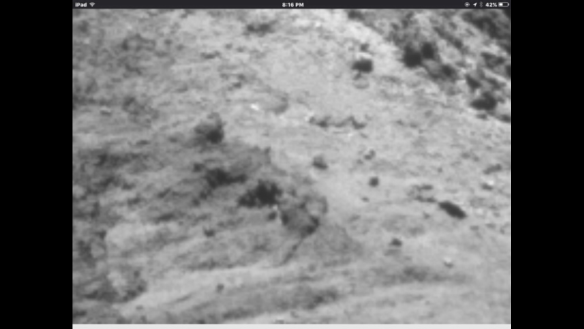
This shows how closely related they are to the W. Notice how the right hand end of the newly found W turns 90° to form a chunky rectangle just like its classic twin (whose rectangle is more visible in the header).
CONCLUSION
This part puts to rest any doubts that Marco Parigi’s boulders moved. His discovery in the first link above is therefore the first documented account of moving boulders on 67P/Churyumov-Gerasimenko.
PHOTO CREDITS
FOR NAVCAM
Copyright ESA/Rosetta/NAVCAM – CC BY-SA IGO 3.0
To view a copy of this licence please visit:
http://creativecommons.org/licenses/by-sa/3.0/igo/
FOR OSIRIS
Credits: ESA/Rosetta/MPS for OSIRIS Team MPS/UPD/LAM/IAA/SSO/INTA/UPM/DyASP/IDA/
All dotted annotations by Andrew Cooper
No comments:
Post a Comment